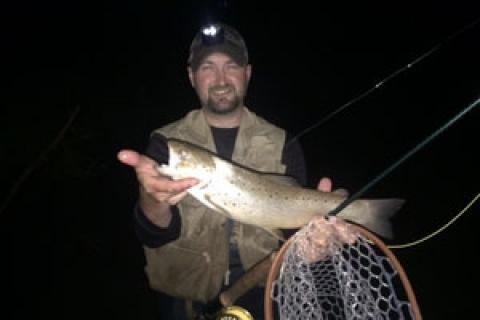
 For two weeks or so every year anglers migrate to riverbanks at dusk to await the annual mayfly hatches. These hatches are some of the most spectacular events a fly fisherman will never see because they happen at night.
For two weeks or so every year anglers migrate to riverbanks at dusk to await the annual mayfly hatches. These hatches are some of the most spectacular events a fly fisherman will never see because they happen at night.
But imagine hundreds of flies and fish feeding everywhere but not being able to fish them. The three simple tips in this blog will change how you fish at night and hopefully increase the number of fish you catch.
#1. Use Your Ears, Not Your Eyes
One of the most important points to understand with night fishing is that you are going to have to use your ears rather than your eyes to locate fish. Get to a fishy-looking run or bank section and hold still. If flies are hatching, fish will be feeding. Don't move up and down looking for fish. Sit quietly and listen for what is going on around you.
As you listen, you will hear a few different types of sounds when fish are feeding: either loud splashes and violent strikes or repetitive slurps. If you are targeting big trout, then choose the fish that is making the repetitive soft slurping sound. This is a big trout just below the surface of the water, sucking flies under into their mouths. These big fish will feed on multiple flies every time they come to the surface giving you a great chance to get the timing right for a bite. The big splash comes from a smaller trout that is chasing drifting flies around the river. These fish will come up to the surface to feed and as they turn to swim back, down kick their tails creating the loud splash you hear.
#2. Get Close to the Fish
If you do hear a fish feeding and you want to try fishing it, don't just let out more line and try a longer cast. Moving to feeding fish is the way to get your flies where they need to be. The fish coming up to feed on flies will not be skittish of you moving around the banks, so getting as close as possible will give you the best chance at getting a bite. One important point to remember is to pick out one fish feeding repetitively and stay on that fish until it stops feeding or slows down. Don't chase multiple fish; try and target one fish at a time.
#3. Measure Out Line Before Dark to Prevent Snags
While you should get as close as you can to fish, establishing a boundary for your fly line in the area you are fishing is also important. What I mean by saying this is that if you get to an area before dark and are planning on trying this spot once the hatch begins, strip out the maximum length of line (the distance to the other shore) then reel in one or two feet. By doing this even if it gets dark you will be able to avoid getting caught on the far side bank. The idea here is quick repetitive casts, keeping your fly in the feeding lane as long as possible.
Try these tips on your next night fishing outing and you will be surprised on how easy it is to find and present flies to fish. Night time is a great time to get big fish to bite, and offers a very different experience than daytime fishing.
- 3170 views

